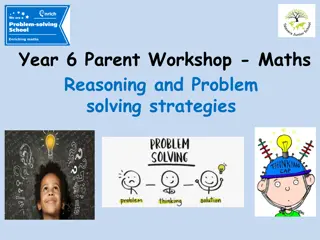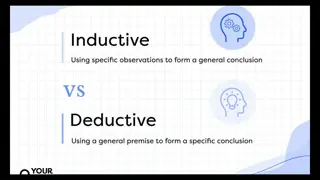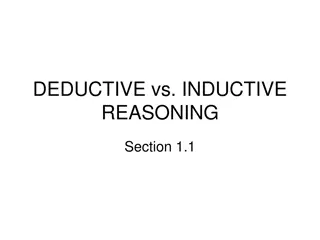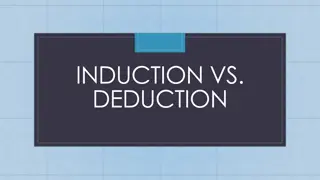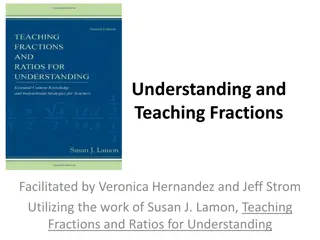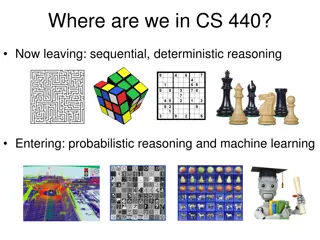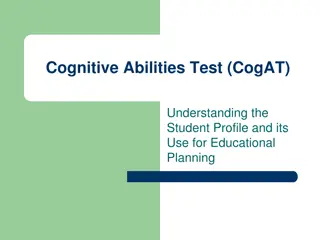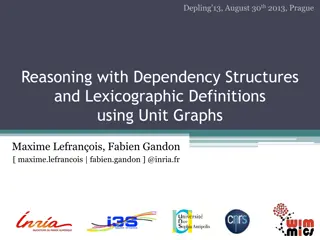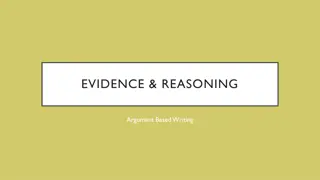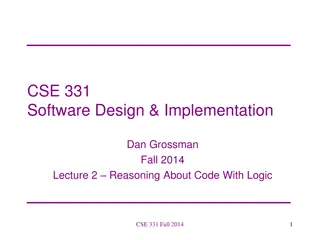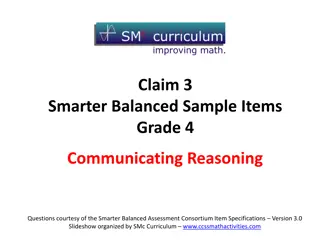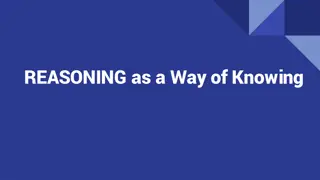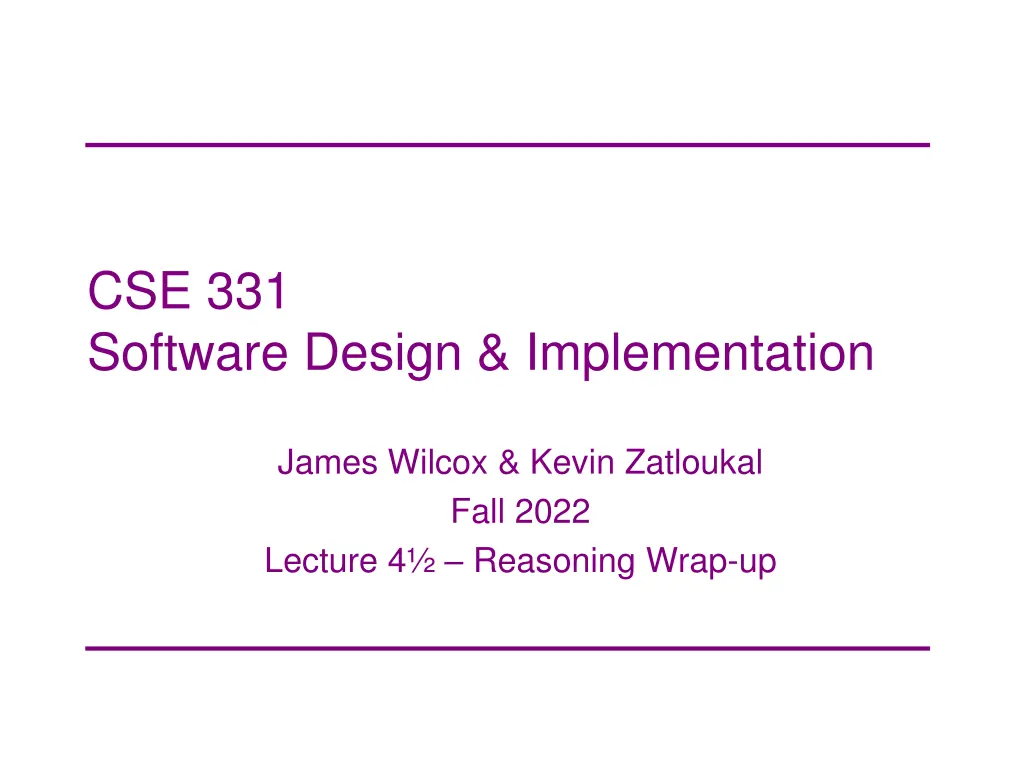
Software Design & Implementation Lecture Recap
Discover key concepts and examples from CSE 331 Software Design & Implementation lecture, including reasoning, pre- and post-conditions, and Dutch National Flag sorting. Get insights into important concepts and practical applications in software design and coding. Stay updated with the latest information and assignments for CSE 331 Fall 2022.
Uploaded on | 1 Views
Download Presentation

Please find below an Image/Link to download the presentation.
The content on the website is provided AS IS for your information and personal use only. It may not be sold, licensed, or shared on other websites without obtaining consent from the author. If you encounter any issues during the download, it is possible that the publisher has removed the file from their server.
You are allowed to download the files provided on this website for personal or commercial use, subject to the condition that they are used lawfully. All files are the property of their respective owners.
The content on the website is provided AS IS for your information and personal use only. It may not be sold, licensed, or shared on other websites without obtaining consent from the author.
E N D
Presentation Transcript
CSE 331 Software Design & Implementation James Wilcox & Kevin Zatloukal Fall 2022 Lecture 4 Reasoning Wrap-up
Administrivia HW2 to be released tonight includes coding part (also has a written problem, independent of the rest) Section tomorrow will get you started on coding part Bring your laptop (if that is where you plan to work) go through the pre-section setup beforehand CSE 331 Fall 2022 2
Example: Dutch National Flag Given an array of red, white, and blue pebbles, sort the array so the red pebbles are at the front, the white pebbles are in the middle, and the blue pebbles are at the end Edsgar Dijkstra CSE 331 Fall 2022 4
Pre- and post-conditions Precondition: Any mix of red, white, and blue Mixed colors: red, white, blue Postcondition: red then white then blue number of each color is unchanged Red White Blue CSE 331 Fall 2022 5
Pre- and post-conditions Precondition: Any mix of red, white, and blue Mixed colors: red, white, blue Postcondition: red then white then blue number of each color is unchanged Red White Blue Want an invariant with postcondition as a special case precondition as a special case (or easy to change to one) CSE 331 Fall 2022 6
Example: Dutch National Flag The first idea that comes to mind: like postcondition like initial condition CSE 331 Fall 2022 7
Example: Dutch National Flag The first idea that comes to mind works. Initial: Iter 5: Iter 10: Iter 15: Post: CSE 331 Fall 2022 8
Other potential invariants Any of these choices work, making the array more-and-more partitioned as you go: Red White Blue Mixed Red White Mixed Blue Mixed Red White Blue Mixed Red White Blue CSE 331 Fall 2022 9
Precise Invariant Need indices to refer to the split points between colors call these i, j, k Red White Mixed Blue Loop Invariant: 0 <= i <= j <= k <= n <= A.length A[0], , A[i-1] are red A[i], , A[j-1] are white A[k], , A[n-1] are blue 0 i j k n No constraints on A[j], ..., A[k-1] CSE 331 Fall 2022 10
Dutch National Flag Code Invariant: Red White Mixed Blue 0 i j k n Initialization? CSE 331 Fall 2022 11
Dutch National Flag Code Invariant: Red White Mixed Blue 0 i j k n Initialization: i = j = 0 and k = n CSE 331 Fall 2022 12
Dutch National Flag Code Invariant: Red White Mixed Blue 0 i j k n Initialization: i = j = 0 and k = n Termination condition? CSE 331 Fall 2022 13
Dutch National Flag Code Invariant: Red White Mixed Blue 0 i j k n Initialization: i = j = 0 and k = n Termination condition: j = k CSE 331 Fall 2022 14
Dutch National Flag Code int i = 0, j = 0; int k = n; {{ Inv: 0 <= i <= j <= k <= n and A[0], , A[i-1] are red and ... }} while (j != k) { need to get j closer to k... let s try increasing j by 1 ?? } CSE 331 Fall 2022 15
Dutch National Flag Code Three cases depending on the value of A[j]: Red White Mixed Blue 0 i j k n A[j] is either red, white, or blue CSE 331 Fall 2022 16
Dutch National Flag Code Three cases depending on the value of A[j]: white Red White Mixed Blue 0 i j k n red Red White Mixed Blue 0 i j k n blue Red White Mixed Blue 0 i j k n CSE 331 Fall 2022 17
Dutch National Flag Code int i = 0, j = 0; int k = n; {{ Inv: 0 <= i <= j <= k <= n and A[0], , A[i-1] are red and ... }} while (j != k) { if (A[j] is white) { j = j+1; } else if (A[j] is blue) { swap A[j], A[k-1]; k = k - 1; } else { // A[j] is red swap A[i], A[j]; i = i + 1; j = j + 1; } } CSE 331 Fall 2022 18
Binary Search CSE 331 Fall 2022 19
Example: Binary Search Problem: Given a sorted array A and a number x, find index of x (or where it would be inserted) in A. Idea: Look at A[n/2] to figure out if x is in A[0], A[1], ..., A[n/2] or in A[n/2+1], ..., A[n-1]. Narrow the search for x on each iteration. (This is an algorithm where you probably still need to go line-by-line even as you get faster at reasoning...) CSE 331 Fall 2022 20
Example: Binary Search Problem: Given a sorted array A and a number x, find index of x (or where it would be inserted) in A. Idea: Look at A[n/2] to figure out if x is in A[0], A[1], ..., A[n/2] or in A[n/2+1], ..., A[n-1]. Narrow the search for x on each iteration. i j n Loop Invariant: A[0], ..., A[i-1] <= x < A[j], ..., A[n-1] A[i], ..., A[j-1] is the part where we don t know relation to x CSE 331 Fall 2022 21
Binary Search Code i j n Initialization? CSE 331 Fall 2022 22
Binary Search Code i j n Initialization: i = 0 and j = n white region is the whole array CSE 331 Fall 2022 23
Binary Search Code i j n Initialization: i = 0 and j = n white region is the whole array Termination condition: i = j white region is empty if x is in the array, it is A[i-1] if there are multiple copies of x, this returns the last CSE 331 Fall 2022 24
Binary Search Code int i = 0; int j = n; {{ Inv: A[0], ..., A[i-1] <= x < A[j], ..., A[n-1] and A is sorted }} while (i != j) { Fall 2022 // need to bring i and j closer together... // (e.g., increase i or decrease j) } {{ A[0], ..., A[i-1] <= x < A[i], ..., A[n-1] }} CSE 331 Fall 2022 25
Binary Search Code int i = 0; int j = n; {{ Inv: A[0], ..., A[i-1] <= x < A[j], ..., A[n-1] and A is sorted }} while (i != j) { int m = (i + j) / 2; if (A[m] <= x) { Look at the element half way between i and j } else { } } {{ A[0], ..., A[i-1] <= x < A[i], ..., A[n-1] }} CSE 331 Fall 2022 26
Binary Search Code int i = 0; int j = n; {{ Inv: A[0], ..., A[i-1] <= x < A[j], ..., A[n-1] and A is sorted }} while (i != j) { int m = (i + j) / 2; if (A[m] <= x) { ?? } else { What goes here? } } {{ A[0], ..., A[i-1] <= x < A[i], ..., A[n-1] }} CSE 331 Fall 2022 27
Binary Search Code int i = 0; int j = n; {{ Inv: A[0], ..., A[i-1] <= x < A[j], ..., A[n-1] and A is sorted }} while (i != j) { int m = (i + j) / 2; if (A[m] <= x) { i = m + 1; } else { Since i-1 = m, we have A[i-1] = A[m] <= x Why do we have A[0] <= <= A[i-1]? } } {{ A[0], ..., A[i-1] <= x < A[i], ..., A[n-1] }} CSE 331 Fall 2022 28
Binary Search Code int i = 0; int j = n; {{ Inv: A[0], ..., A[i-1] <= x < A[j], ..., A[n-1] and A is sorted }} while (i != j) { int m = (i + j) / 2; if (A[m] <= x) { i = m + 1; } else { invariant satisfied since A[i-1] = A[m] <= x and A is sorted so A[0] <= <= A[m] } } {{ A[0], ..., A[i-1] <= x < A[i], ..., A[n-1] }} CSE 331 Fall 2022 29
Binary Search Code int i = 0; int j = n; {{ Inv: A[0], ..., A[i-1] <= x < A[j], ..., A[n-1] and A is sorted }} while (i != j) { int m = (i + j) / 2; if (A[m] <= x) { i = m + 1; } else { ?? } } {{ A[0], ..., A[i-1] <= x < A[i], ..., A[n-1] }} What goes here? CSE 331 Fall 2022 30
Binary Search Code int i = 0; int j = n; {{ Inv: A[0], ..., A[i-1] <= x < A[j], ..., A[n-1] and A is sorted }} while (i != j) { int m = (i + j) / 2; if (A[m] <= x) { i = m + 1; } else { j = m; } } {{ A[0], ..., A[i-1] <= x < A[i], ..., A[n-1] }} invariant satisfied since x < A[m] = A[j] (and A is sorted so A[m] <= ... <= A[n-1]) CSE 331 Fall 2022 31
Binary Search Code int i = 0; int j = n; {{ Inv: A[0], ..., A[i-1] <= x < A[j], ..., A[n-1] and A is sorted }} while (i != j) { int m = (i + j) / 2; if (A[m] <= x) { i = m + 1; } else { j = m; } } {{ A[0], ..., A[i-1] <= x < A[i], ..., A[n-1] }} Does this always terminate? CSE 331 Fall 2022 32
Binary Search Code int i = 0; int j = n; {{ Inv: A[0], ..., A[i-1] <= x < A[j], ..., A[n-1] and A is sorted }} while (i != j) { int m = (i + j) / 2; if (A[m] <= x) { i = m + 1; } else { j = m; } } {{ A[0], ..., A[i-1] <= x < A[i], ..., A[n-1] }} Must satisfy i <= m < j (Why?) CSE 331 Fall 2022 33
Binary Search Code int i = 0; int j = n; {{ Inv: A[0], ..., A[i-1] <= x < A[j], ..., A[n-1] and A is sorted }} while (i != j) { int m = (i + j) / 2; if (A[m] <= x) { i = m + 1; } else { j = m; } } {{ A[0], ..., A[i-1] <= x < A[i], ..., A[n-1] }} Must satisfy i <= m < j so i increases or j decreases on every iteration CSE 331 Fall 2022 34
Binary Search Code int i = 0; int j = n; {{ Inv: A[0], ..., A[i-1] <= x < A[j], ..., A[n-1] and A is sorted }} while (i != j) { int m = (i + j) / 2; if (A[m] <= x) { i = m + 1; } else { j = m; } } {{ A[0], ..., A[i-1] <= x < A[i], ..., A[n-1] }} Is that all we need to do? CSE 331 Fall 2022 35
Reasoning Summary Checking correctness can be a mechanical process using forward or backward reasoning This requires that loop invariants are provided those cannot be produced automatically Provided you document your loop invariants, it should not be too hard for someone else to review your code CSE 331 Fall 2022 37
Documenting Loop Invariants Write down loop invariants for all non-trivial code They are often best avoided for for each loops: {{ Inv: printed all the strings seen so far }} for (String s : L) System.out.println(s); CSE 331 Fall 2022 38
Documenting Loop Invariants Write down loop invariants for all non-trivial code They are often best avoided for for each loops: // Print the strings in L, one per line. for (String s : L) System.out.println(s); CSE 331 Fall 2022 39
Documenting Loop Invariants Write down loop invariants for all non-trivial code They are often best avoided for for each loops. Invariants are more helpful when a variable incorporates information from multiple iterations e.g., {{ s = A[0] + + A[i-1] }} Use your best judgement! CSE 331 Fall 2022 40
Reasoning Summary Correctness: tools, inspection, testing need all three to ensure high quality especially cannot leave out inspection Inspection (by reasoning) means reasoning through your own code do code reviews Practice! essential skill for professional programmers CSE 331 Fall 2022 41
Reasoning Summary You will eventually do this in your head for most code Formalism remains useful especially tricky problems interview questions (often tricky) see last example CSE 331 Fall 2022 42
A Problem Complete this method such that it returns the location of the largest value in the first n elements of the array arr. int maxLoc(int[] arr, int n) { ... } CSE 331 Fall 2022 44
One Solution int maxLoc(int[] arr, int n) { int maxIndex = 0; int maxValue = arr[0]; // Inv: maxValue = max of arr[0] .. arr[i-1] and // maxValue = arr[maxIndex] for (int i = 1; i < n; i++) { if (arr[i] > maxValue) { maxIndex = i; maxValue = arr[i]; } } return maxIndex; } Is this code correct? What if n = 0? What if n > arr.length? What if there are two maximums? CSE 331 Fall 2022 45
A Problem Complete this method such that it returns the location of the largest value in the first n elements of the array arr. int maxLoc(int[] arr, int n) { ... } Could we write a specification so that this is a correct solution? precondition that n > 0 throw ArrayOutOfBoundsException if n > arr.length return smallest index achieving maximum CSE 331 Fall 2022 46
Morals You can all write the code correctly Writing the specification was harder than the code multiple choices for the right specification must carefully think through corner cases once the specification is chosen, code is straightforward (both of those will be recurrent themes) Some math (e.g. if n <= 0 ) often shows up in specifications English ( if n is less or equal to than 0 ) is often worse CSE 331 Fall 2022 47
How to Check Correctness Step 1: need a specification for the function can t argue correctness if we don t know what it should do surprisingly difficult to write! Step 2: determine whether the code meets the specification apply reasoning usually easy with the tools we learned CSE 331 Fall 2022 48
Sorted Matrix Search Problem Description Given a matrix M (of size m x n), where every row and every column is sorted, find out whether a given number x is in the matrix. CSE 331 Fall 2022 50

